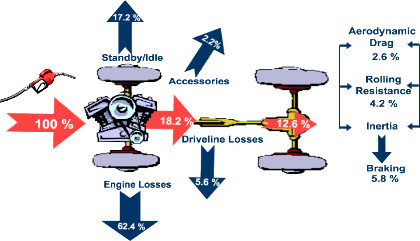
Why is the Quasiturbine (Qurbine)
a superior engine for vehicles ?
Photo-detonation and Diesel versus cycle
Otto
At low load factor, the intake depressurization of the Otto cycle
dissipates power from the engine since the throttle valve is almost closed and
the descending piston acts as a clogged vacuum pump against the atmospheric pressure,
which vacuum is subsequently partially destroyed
by fuel vaporization during the compression. Due to this effect, the engine in
Otto cycle opposes to all RPM revolution increase (well known as the engine
compression braking) and this intrinsic resistance to speed augmentation is compensated
by a constant and important fuel consumption. The photo-detonation mode does not use any
throttle valve and accept without constraint all available air at atmospheric
pressure (similarly as the Diesel, where the pressurization energy is restituted
at the time of relaxation). For this reason, the efficiency at low load factor
of the photo-detonation engine is twice that of the conventional Otto cycle, and
considering that the load factor of a car is in average of about 10 to 15%, this
is not a small difference (saving is still superior in the traffic jams...).
|
The relation between the hybrid
vehicle concept and the Quasiturbine photo-detonation engine. |
The used energy repartition in automobile is
given at:
http://www.fueleconomy.gov/feg/atv.shtml

A
return towards the efficient and clean combustion engines :
The problematic of power-energy in vehicles
(Quasiturbine - An optimum solution the a half-HP vehicles !)
The vehicles make on average 20 000 km per annum,
that is to say an average of 54 km per day,
at 100 Km/h, that corresponds to approximately half an hour of service per day.A conventional gasoline vehicle does on average
use approximately 12% of its working installed power,
that is to say 12% of 150 HP or 18 HP (14 kW).
18 HP during half-an-hour correspond to an average power
on an annual basis of 0,4 HP (0,3 kW) by vehicles.
There is little loss with electricity (the losses having already been done at the station)
but to satisfied this need with average efficiency combustion engine
5 to 8 time this amount will have to be supply buy the fuel in thermal form.
Vehicles 4 times more efficient (golf kart like car do better) will require
only 0,1 HP (75 Watts) on an annual basis,
that is to say the equivalent of an always lit bulb!Considering that a standard hydro-water dam turbine
can produce an annual average power from 200 to 300 MW,
it would be enough in theory to drive a fleet of
800 000 current vehicles demanding 0,4 HP (0,3 kW) each,
and 3 million vehicles of the future at 0,1 HP (75 Watts),
that is to say the totality of the vehicles of Québec!
This average current power of 0,4 HP corresponds to less
than the peak power installed in our domestic refrigerators.
The paradox to be solved with the vehicles is that
they ask for large instantaneous power, but low annual energy consumption.
This explains why it is non-competitive to put
in the vehicles 20,000 or 30,000 $ high-tech engines
which will only develop 0,5 HP on an annual average!
The race for efficiency is thus not here a critical argument.Although these average observations are right,
the instantaneous distribution of power varies enormously,
so that the electric scenario requires that one spread out
the demand of power during day and night.
However, this is exactly what the refill of the batteries allows to make,
and so, removing the daily peak while charging at rate of 0,5 HP (400 Watts)
over 24 hours and by delivering the power at 20 HP or more
during the daily half-an-hour vehicle service period.However, the batteries have the defects of their qualities,
it is generally necessary to charge and discharge them slowly,
they have a low energy density compared to the gasoline,
they are generally made of hostile materials to the environment,
their lifespan is quite limited,
and their weight and size reduce the effectiveness in the mobile applications.
The hybrids battery-generators attenuate these disadvantages,
but they add new ones.
Environmentally, batteries themselves used in great number
will be a major environmental concern.
In addition, if the energy that they contain is low polluting,
the initial electrical source is generally always polluting.Considering the high installed power capacity required,
L'électrification des véhicules à partir d'un moteur électrique central
and the relatively low annual energy demand.
Considering that technologies without the point of use pollution
do displace and concentrate the pollution at the source.
Considering that transformations between forms of energy
reduce the total energy effectiveness ineluctably.
And excluding for the moment the nuclear and fusion power (logical for hydrogen),
force are we to note that the solutions offered
by super gadgets high-tech-fuel-cell-and-batteries
are only apparent and fragmentary, without being really sustainable.
They are especially scientific and technological explorations,
except for area like in Québec which has hydro-power,
where those solutions are challenging certain strong empires
... who did not have liked the pertinent Couture propulsion train
(in-wheel motor of Hydro-Quebec) ... considering that this technology
is one of the few to present a word-wide interest
in hybrid mode with combustion engine (less batteries),
and it would be even more strategic with the Quasiturbine
(Note that a photo-detonation Quasiturbine would suppress all interest
and need for hybrid vehicle concept, since a powerful
Quasiturbine engine would have a modeste low regime penalty !).
est une voie facile qui ne requiert pas de moteurs électriques sophistiqués,
puisque la distribution des couples est assurée par le différentiel mécanique.
C'est une voie temporaire et vulnérable, parce qu'elle conserve les crémaillères et cardans
que l'usage de multiples moteurs roues viendront tôt ou tard substituer.
L'abandon du moteur roue est malheureusement un virage à courte vue
et une reconnaissance de notre manque de volonté à résoudre
la problématique du contrôle en couple des moteurs du train de propulsion,
une technologie cruciale qui vaudra des milliards de $ à ses conquérants :
Les japonais probablement ? ... alors que le Québec était si près de la solution !Isoler l'hydrogène à partir des hydrocarbures fossiles
fait perdre au bas mot 30 % de l'énergie initiale.
Ensuite, stocker l'hydrogène gazeux est aussi coûteux
en énergie de compression souvent perdue à la détente.
Suite à une décennie exploratoire sur l'hydrogène,
on redécouvrira sous peu que la meilleure façon de stocker l'hydrogène
est de le lier tout autour d'un atome de carbone CH4 , C3H6 ...
pour former des gaz liquéfiables ou directement des liquides
qu'on appel hydro- (pour hydrogène) et carbure (pour combustion).
On redécouvrira que nous fonctionnons déjà à l'hydrogène
sous une forme efficace et peu dangereuse !Il est aussi à la fois amusant et désolant de constater
comment on présente la comparaison de l'incomparable.
Les voitures conventionnels sont robustes, lourdes et puissantes,
alors que les nouvelles technologies présentent des vélos 2 places enveloppés d'une bulle.
Ce type de tricherie va rebondir violemment,
parce que si on utilisait les moteurs conventionnels pour propulser ces vélos,
la consommation tomberait en dessous d'un 1 litres au 100 km,
avec une nécessité de faire le plein seulement 4 fois l'an !So, for most area of the world, liquid fuels (fossil or synthetic) are still by far
the best way to concentrate and to transport autonomous energy,
and with the combustion engines like partners,
they offer an unequalled perspective solution for mobility,
towards which one inevitably returns and will return.
The race for the efficiency and environmental cleanliness is here a critical argument.
Rather than to give up this axis of logical solution, which is not fashionable for now,
one should intensify the efforts for its further improvement.
Potential of improvement is still enormous with photo-detonation
http://quasiturbine.promci.qc.ca/QTPhotodetonation.html
which could reduce the CO2 emission by half,
being more than the Kyoto protocol,
and without modifying the weight, the power and the autonomy of our vehicles !
There is also a great potential for the Quasiturbine-Stirling-Steam
http://quasiturbine.promci.qc.ca/QTStirling.html
which could produced several HPs continuously for many years
base on a small simple nuclear pellet...L'approche dure des dernières décennies minimise l'importance de la ressource
et permet d'affirmer que "les véhicules conventionnelles ont une meilleure autonomie
que les véhicules à propulsion alternative". Cependant, l'approche des sociétés
écologiques du future met l'accent avec justesse l'importance de la ressource,
et permet aussi d'affirmer avec raison "qu'avec une même quantité d'énergie embarquée,
la propulsion alternative est plus performante et permet une meilleure autonomie...".
Nous évoluerons inévitablement d'une vision vers l'autre.For this reason Quasiturbine technology will be impossible to circumvent
in the world of mobility. .. and elsewhere.
Fashion should not blind science and technology !
The use of the Quasiturbine for vehicle propulsion suggests 6 different concepts :
1: QCV - QUASITURBINE CONVENTIONAL VEHICLE (QT400/4)
2: QHV - (Evolving to QHHV or QHZPV) QUASITURBINE HYBRID VEHICLE
(QT50/4)
3: QZPPV - QUASITURBINE ZERO POLLUTION PNEUMATIC VEHICLE (QT50/2F)
4: QZPCV - QUASITURBINE ZERO POLLUTION CRYO-VEHICLE (QT50/2F)
5: QSV - QUASITURBINE STEAM VEHICLE (QT50/2F)
6: QICHV - QUASITURBINE I. C. HYDROGEN VEHICLE (QT400/4)
The Quasiturbine-Stirling engine for hybrid vehicle is described at: http://quasiturbine.promci.qc.ca/QTStirling.html
To power the most popular vehicles with each of the 6 Quasiturbine concepts detailed
below,
one needs to manufacture essentially only the 2 basic Quasiturbine engines as follows :
QT50 - DESCRIPTION OF THE 50cc CHAMBER QUASITURBINE
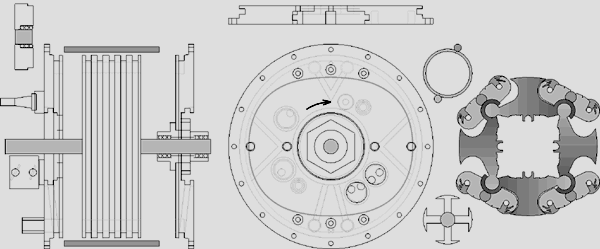
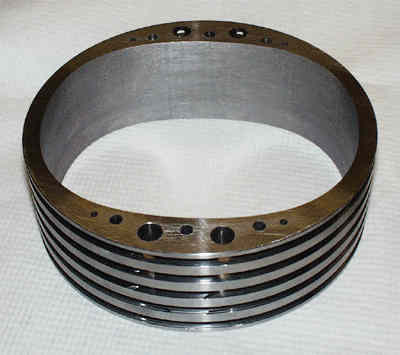
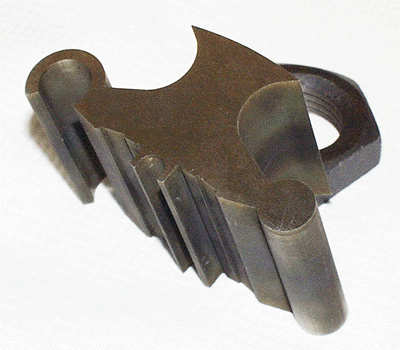
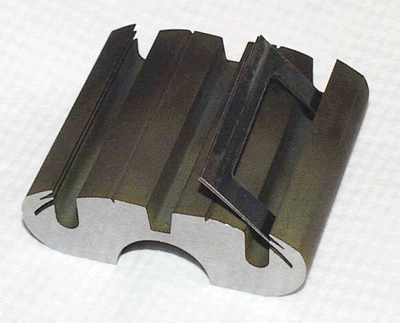
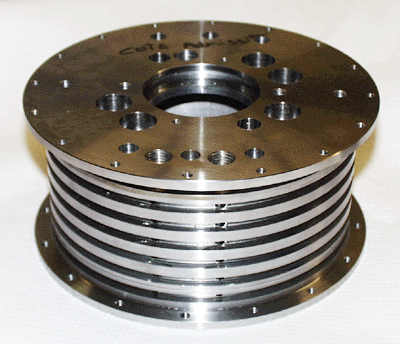
External stator diameter 7.5"
Thickness 3.25"
Rotor Diam. max. = 5.57"
Thickness =
2.00"
Engine target weight excluding facultative shaft : 20 pounds
Aspirated volume in 4 strokes internal combustion mode (4 chambers per revolution) =
200 cc per revolution
Aspirated volume in 2 strokes internal combustion mode or compressed fluid mode (8
chambers per revolution) = 400 cc per revolution
Max. Rated speed: 3000 RPM
(Please do not rate maximum < Shaft Power > at more than 3000 RPM for small engine,
and 2000 RPM for larger engine).
(Note that theoretically, the rotor perimeter would reach sound speed in atmospheric air
at about 30,000 RPM)
(Note: 1 lbforce = 4.44 N; 1 foot = 0.303 m; 1 H.P. = 746 watts)
QT50/4 - 4 strokes Internal Combustion engine :
Power through pressure calculation :
Assuming an average internal pressure of 200 psi (not actually measured)
< Shaft power > at 3000 rpm in the range of 14.0 HP or 10.5 Kw
Power through consumption calculation :
A 200 cc/rev aspirated volume require about 0,0224 cc/rev of gasoline.
At 3000 rpm and 29% efficiency = 10.5 Kw (mechanical) or 14.0 HP
QT50/2 - 2 strokes Internal Combustion engine :
The two strokes are compression-expansion (In the 2 strokes pressurized Fluid
Quasiturbine QT50/2F, the 2 strokes are expansion-exhaust).
This is a very high power, volume and weight density engine, but it does polluate as much
as the 2 strokes piston engine.
We do not consider it for the present application.
QT50/2F - 2 strokes pressurized Fluid energy converter - Power
calculation (Pneumatic, steam, cryogenic ...) :
In this mode, pressurized fluid is injected simultaneously in both the top and
the bottom chamber. The two strokes are expansion-exhaust (In the 2 strokes internal
combustion Quasiturbine QT50/2 not consider here, the 2 strokes are
compression-expansion). 8 expansions are produced in every rotation. Here is one set of
calculated data for an effective internal differential pressure of 500 psi (power reaches
60 HP at 3000 rpm).
QT400 - DESCRIPTION OF THE 400cc CHAMBER QUASITURBINE
(This engine is identical as the QT50 here up, except that all dimensions
are double. See previous diagram and photos for details).
External stator diameter 15"
Thickness 6.5"
Rotor Diam. max. = 11.14"
Thickness =
4.00"
Engine target weight excluding the facultative shaft : 80 pounds
Aspirated volume in 4 strokes internal combustion mode (4 chambers per revolution) =
1600 cc per revolution
Aspirated volume in 2 strokes internal combustion mode or compressed fluid mode (8
chambers per revolution) = 3200 cc per revolution
Max. Rated speed: 2000 RPM
(Please do not rate maximum < Shaft Power > at more than 2000 RPM for large engine).
(Note that theoretically, the rotor perimeter would reach sound speed in atmospheric air
at about 15,000 RPM)
(Note: 1 lbforce = 4.44 N; 1 foot = 0.303 m; 1 H.P. = 746 watts)
QT400/4 - 4 strokes Internal Combustion engine :
Power through pressure calculation
Assuming an average internal pressure 200 psi (not actually measured)
< Shaft power > at 2000 rpm is in the range of 75 HP or 56 Kw
Power through consumption calculation
A 1600 cc/rev aspirated volume require about 0,1792 cc/rev of gasoline.
At 2000 rpm and 29% efficiency = 56.1 Kw (mechanical) or 75 HP
QT400/2 - 2 strokes Internal Combustion engine :
The two strokes are compression-expansion (In the 2 strokes pressurized Fluid
Quasiturbine QT400/2F, the 2 strokes are expansion-exhaust).
This is a very high power, volume and weight density engine, but it does polluate
as much as the 2 strokes piston engine.
We do not consider it for the present application.
QT400/2F - 2 strokes pressurized Fluid energy converter - Power
calculation (Pneumatic, steam, cryogenic ...) :
This mode would produce power in excess of 500 HP ! It is not considered here.
* * * * *
6 DIFFERENT QUASITURBINE VEHICLE CONCEPTS
The use of Quasiturbine for vehicle propulsion suggests at least 6
different engine applications. For each one, it could be assume that :
- The engine size and weight will be at least 1/5 of the conventional piston engine.
- The Quasiturbine is so quiet, that little muffler sound attenuator would be required.
- Being a zerovibration engine, no special damping support is required, neither a
separated and well-insulated engine compartment.
- The Quasiturbine being a low rpm high torque engine, there will be no need for a
conventional gearbox (except for reverse).
However, a constant gear ratio may be required such that at maximum loaded engine rpm, the
vehicle is going near its maximum speed.
- Furthermore, since the quasiturbine can run in all orientations, it could easily be
fixed with vertical shaft (with only a clutch, no gearbox) directly on the wheel
differential, having its driving shaft directed up-ward straight into the Quasiturbine.
- Alternatively, since both ends of the Quasiturbine shaft can give full take-off power,
it could be located with the shaft in line within two wheels.
- More thermodynamically efficient. Saving an extra 8 to 10% by suppressing the gearbox,
and substantial additional saving over the vehicle live time by weight reduction.
- Less polluant (500 times less NOx ?).
- Idle can be as low as 200 rpm; and 0 rpm (complete stop and restart when needed) for
fluid energy converter mode (pneumatic, steam, cryogenic ...).
QT50 maximum revolution is 3000 rpm, QT400 maximum revolution is 2000 rpm (higher value
may be possible ?).
- Unseen accelerations ! The Quasiturbine has no dead time and no flywheels (which are
responsible for slowing the vehicle acceleration).
1: QCV - QUASITURBINE CONVENTIONAL VEHICLE (QT400/4)
Using a Quasiturbine gas (or diesel, CNG, biofuel ...) engine in a conventional way. This
vehicle would still be quite unconventional with its reduce weight, and no gearbox. In
internal combustion mode, the Quasiturbine is photo-detonation compatible, which means
that unlike the piston engine which can not stand it, combustion will be faster and more
complete.
Engine accessories : Conventional fuel tank; no gearbox; Space for QT400
Quasiturbine.
Consumption : Gallon of fuel / hour.
2: QHV - (Evolving to QHHV or QHZPV) QUASITURBINE HYBRID VEHICLE
(QT50/4)
(Note : Later, this concept could evolve to QHHV - QUASITURBINE HYDROGEN HYBRID
VEHICLE, having the QT50/4 running with pure hydrogen, or to QHZPV
- QUASITURBINE HYBRID ZERO POLLUTION VEHICLE, pneumatic or cryogenic)
Use with WHEEL MOTOR traction group or otherwise, the Quasiturbine "onboard
generator" would recharge the batteries. It does meet all the required qualities :
- Zero vibration (the small engines are generally too shaky !)
- Compact (5 times less cumbersome than a piston engine)
- Lighter (5 times less heavy than an equivalent piston engine)
- Less noisy (without muffler : 20 times less than an equivalent piston engine)
- More efficient and less polluant (500 times less NOx ?)
- And much more ...
Engine accessories : Conventional small fuel tank; space for the
"Quasiturbine 14 HP onboard generator"; space for battries.
Consumption : On/off at nominal rate gallon of gasoline / hour. only
while running; Batteries wear-out consumption ?
3: QZPPV - QUASITURBINE ZERO POLLUTION PNEUMATIC VEHICLE (QT50/2F)
Compressed fluid like air is also a good way to store energy. The concept is already being
marketed world wide by http://www.zeropollution.com
storing up to 3000 psi. By default, they are using piston air engines, but the
Quasiturbine would be a great improvement. Pneumatic engine power density being higher
than Internal Combustion mode, this Quasiturbine would be very small: A rotor of 5
1/4" diameter by 2" thick, weighting less than 20 pounds produces up to 60 CV at
3000 rpm.
Engine accessories : Large compressed air tank (fiberglass tubing ?) is
needed; Very small space for the QT50 Quasiturbine is needed. Space for on-board
compressor if required ?
Consumption : Cubic feet / minute (cfm) normalize to atmospheric
pressure; Vehicle has a constant weight !
4: QZPCV - QUASITURBINE ZERO POLLUTION CRYO-VEHICLE (QT50/2F)
When liquid nitrogen is evaporated up to the ambient temperature in a close evaporator, it
can produce very high pressure. Assuming that an ambient temperature heat source is always
available for free, a gallon of liquid nitrogen contains just a little less mechanical
energy than a gallon of gasoline (liquid nitrogen is pure mechanical energy, while
gasoline is 1/3 mechanical, 2/3 thermal), and it is zero pollution ! (In the future,
carbon sequestration policy would generate a large quantity of liquid nitrogen everywhere
...) The Washington State University has already made a Cryocar. http://www.aa.washington.edu/AERP/CRYOCAR/HomePage/Index.htm
Again, they were using an air piston engine, but the Quasiturbine would be a great
improvement. Pneumatic engine power density being higher than Internal Combustion mode,
this Quasiturbine would be very small: A rotor of 5 1/4" diameter by 2" thick,
weighting less than 20 pounds produces up to 60 CV at 3000 rpm. A nitrogen motorcycle is
currently being made by the Cegep de Rimouski for the summer 2001.
Engine accessories : Conventional size Dewar cryogenic liquid nitrogen
tank; Very small space for the QT50 Quasiturbine is needed. Small space for the nitrogen
evaporator and heat exchanger.
Consumption : Cubic feet / minute (cfm) normalize to atmospheric
pressure, translated in gallon of liquid nitrogen / hour.
5: QSV - QUASITURBINE STEAM VEHICLE (QT50/2F)
At the beginning of the century, electrical and steam vehicles were common. Still today,
steam car competitions occur each year http://www.steamautomobile.com
. Steam engine is particularly interesting for countries where fossil fuels are not
available. It can work with all sorts of raw material combustibles. Because the
Quasiturbine can accept saturated steam (which conventional turbine cannot) and run at low
rpm (no need of reduction), we think it will revolutionize the use of steam and solar
energy. In fact, the Quasiturbine can be directly heated, and will accept direct cold
water injection, a concept where the Quasiturbine is at once the flash steam generator and
the engine ! (Could work at very high pressure without much law restriction, since there
is no dangerous stand-by steam, and the only steam is generated in the engine, and exits
at low atmospheric level). Steam engine power density being higher than Internal
Combustion mode, this Quasiturbine would be very small: A rotor of 5 1/4" diameter by
2" thick, weighting less than 20 pounds produces up to 60 CV at 3000 rpm.
Engine accessories : Conventional size fuel storage; Very small space for
the QT50 Quasiturbine is needed; Space for the furnace or boiler; Small liquid reservoir;
Space for condenser if close circuit is wanted.
Consumption : Cubic feet / minute (cfm) normalize to atmospheric
pressure, translated into pounds of steam / hour (Open or closed circuits); + fuel storage
consumption lbs / hour.
6: QICHV - QUASITURBINE I. C. HYDROGEN VEHICLE (QT400/4)
Everyone talks about hydrogen as the major future energy fuel. To our understanding, the
Quasiturbine is one of the only engines potentially able to burn 100% hydrogen fuel.
Furthermore, due to its special narrow confinement pressure impulse, the Quasiturbine
considerably reduces the NOx produced by hot H2 combustion. Also, since hydrogen degrades
all oils, the oil-free Quasiturbine will be a must ! Due to the lower specific energy of
hydrogen, power characteristics of the gasoline engine must be reduced by about 30% to
applied here.
Engine accessories : Large hydrogen fuel tank (compressed or liquid); no
gearbox; Space for QT400 Quasiturbine.
Consumption : Cubic feet / minute (cfm) normalize to atmospheric
pressure, translated in gallon or pounds of hydrogen / hour; Vehicle has a constant weight
!
Engine Map - DOE - NREL "vehicle system model"
"VEHICLE SYSTEM MODEL" The US Department of Energy (NREL - National Renewable Energy Laboratory) has created a "vehicle system model" and uses it to screen new and promising (and not so promising) components. This simulator can help establishing how an engine performs over a selected duty cycles for various vehicle setups. This "vehicle system model" can be download free at http://www.ctts.nrel.gov/analysis . A demo is at http://www.ctts.nrel.gov/analysis/demo/page2a.htm .
The Quasiturbine is universal in relation to
energy sources :
Liquid and gaseous fuel, hydrogen, steam, pneumatic, hydraulic...
| Return to main menu |
Quasiturbine Agence Inc., Promotional
Agent for the Quasiturbine Continuous Combustion Rotary Engine or Compressor
Casier 2804, 3535 Ave Papineau, Montréal Québec H2K 4J9 CANADA (514) 527-8484 Fax (514)
527-9530
http://quasiturbine.promci.qc.ca
quasiturbine@promci.qc.ca